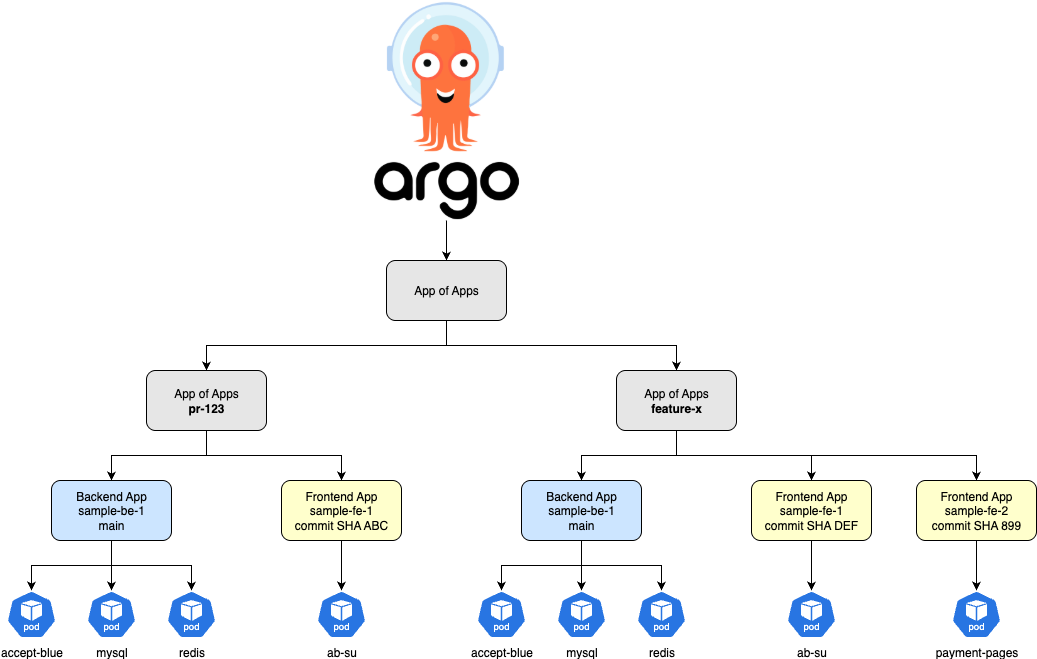Blueberry IDP Architecture
Comprehensive insights into how the Internal Developer Platform is designed, deployed, and operates.
Overview
The Blueberry IDP is built as a modern, cloud-native platform that automates the creation and management of ephemeral development environments using GitOps principles.
Architecture Diagrams
App-of-Apps Pattern

The platform uses ArgoCD's App-of-Apps pattern to manage multiple applications and environments in a hierarchical structure.
Core Components
Networking & Ingress
Learn about the networking architecture, static IP management, ingress setup, and traffic flow.
Authentication & Security
Firebase Auth integration, API tokens, RBAC, and comprehensive security policies.
GitOps & ArgoCD
Coming Soon - How ArgoCD manages deployments using the App-of-Apps pattern.
Container Management
Coming Soon - Artifact Registry, image management, and container security.
Infrastructure
Coming Soon - GKE Autopilot, Terraform modules, and cloud resource management.
Configuration & Secrets
Comprehensive guide to configuration management and secrets handling with Google Secret Manager.
System Architecture
Infrastructure
- Kubernetes: GKE Autopilot (serverless Kubernetes)
- CI/CD: ArgoCD with App-of-Apps pattern, GitLab
- IaC: Terraform for base infrastructure
- Storage: Firestore (metadata) + GCS (artifacts/logs)
- Auth: Firebase Auth (internal + external users)
Application Layer
- Backend: Python FastAPI
- Frontend: HTMX + Alpine.js (server-side rendered)
- Templates: Jinja2
- Cache: Redis (deployed as Helm sub-chart)
Key Design Principles
Environment Lifecycle
Main Lifecycle Flow
Created
Triggered
Config
Application
Provisioning
Active
Request
Cleaned Up
Error Handling
Provisioning Failed
If step 5 fails:
- • Manual cleanup option
- • Retry provisioning
- • Error notification sent
Retry Mechanism
Automatic retry logic:
- • Returns to step 5
- • Limited retry attempts
- • Exponential backoff
Environment lifecycle from creation to deletion with error handling
Resource Organization
Naming Conventions
-
Environments:
pr-{number}or{custom-name} -
Namespaces:
{env-id} -
ArgoCD Apps:
env-{env-id} -
DNS:
{env-name}.ephemeral.blueberry.florenciacomuzzi.com
Directory Structure
blueberry-terraform/ # Infrastructure as Code
argocd-apps/ # ArgoCD application definitions
blueberry/ # Core application code
src/ # FastAPI backend
helm/ # Helm charts
templates/ # Jinja2 templates for ArgoCD apps
charts/ # Helm charts
tests/ # Test suitesGetting Started
To understand how all these components work together:
- 1. Start with Networking & Ingress to understand traffic flow
- 2. Review the Authentication & Security setup
- 3. Dive into GitOps workflows (coming soon)
- 4. Explore infrastructure provisioning (coming soon)
This documentation is continuously updated as the platform evolves. For the latest technical details, check the GitLab repository.